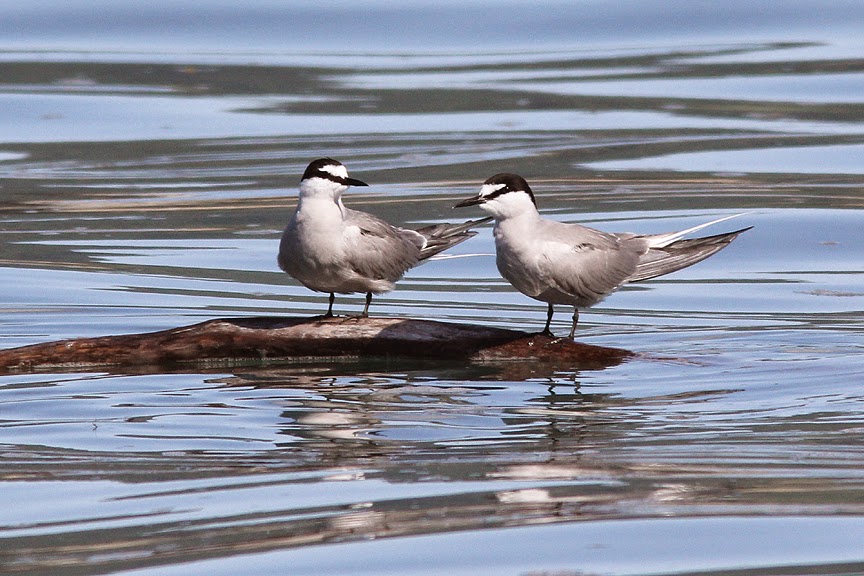For this post we stay in Kachemak Bay, Alaska, and take a look at some of the other birds we saw that afternoon. I knew this would be a big day, if not for total number of species, at least for number of new to me species. I was right. Life list birds just kept coming and coming.
As we puttered slowly through the bay we spotted a pair of Aleutian Terns perched on a floating log. I am partial to terns, with their long wings and short legs. They are graceful and acrobatic fliers, and I love watching them stoop and dive into the water.
 |
| Aleutian Terns rest on a log. |
As we floated closer to the pair they took off, with one of them flying right by the boat.
 |
| Aleutian Tern in flight. |
We saw many species where just a few birds were present. This pair of Pigeon Guillemots watched us closely...
 |
| Pigeon Guillemots. |
...until they too had had enough and took to the air. I felt kind of bad about disturbing all these birds, but it was nice to get to see them in flight--how else would we have seen those bright orange legs?
 |
| Pigeon Guillemot takes flight. I'm always happy when I manage to get these "action shots" in focus! |
As the day moved on the breeze picked up a bit and the water got a little choppier. We were making our way to Gull Island when someone spotted these Tufted Puffins. I cannot tell you what a stir they caused. Such a dynamic and sought-after bird, their clown-like faces are a delight.
 |
| Tufted Puffins. |
One of them was gathering nesting material. They too nest on Gull Island, although I did not see any on the island itself.
 |
| Tufted Puffin with nesting material. |
A little bit later, as the bay became choppier still, a pair of Horned Puffins showed up. I couldn't believe our luck!
 |
| Horned Puffins. Notice the difference in bill color, lack of tufts, and the black "horns" around their eyes. |
So now we're back to the cacophony of Gull Island. Last time I showed you kittiwakes, this time we will marvel at the Common Murres. Thousands of Common Murres.
 |
| A large raft of Common Murres floats near Gull Island, with the Kenai Mountains in the background. |
The bay was thick with these birds.
 |
| Common Murres. |
Looking closely at these Common Murres, one can see they are made for diving. They are often compared to penguins but I think they more closely resemble loons, with their super-smooth heads and stout bills. Much like loons, their legs are set back quite far on their bodies, which makes them good swimmers but not so good on land. The only time they're on land is to nest.
Here you can see their very upright posture, a result of their legs being so far back. Common Murres don't build nests--they lay a single egg directly on the rock.
 |
| Common Murres on Gull Island. |
While we floated around Gull Island, more and more murres kept arriving. It was simply fantastic.
In all I saw 14 different species out on Kachemak Bay, 11 of which were lifers. It was a fine afternoon of birding. But the highlight of the day wasn't a winged creature--it had whiskers, big floppy back feet and floated around on its back, making us all squeal with delight.
Next: Sea Otters!!

















































